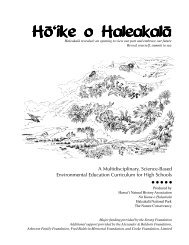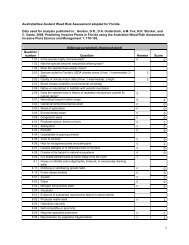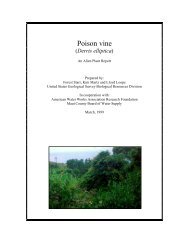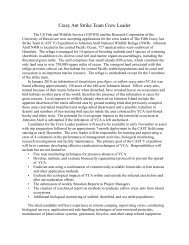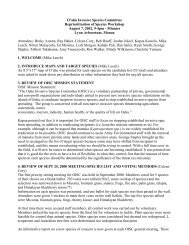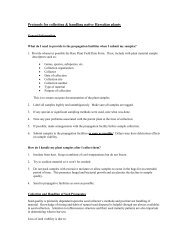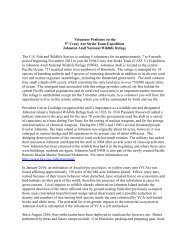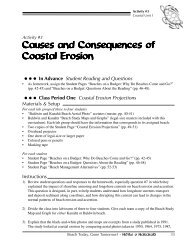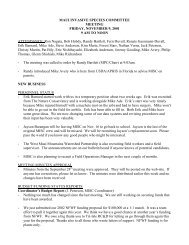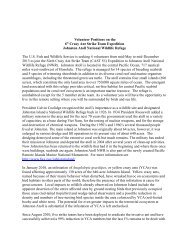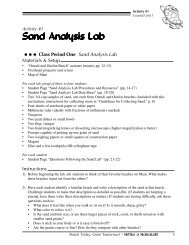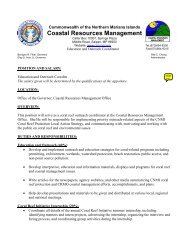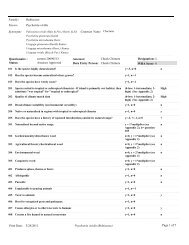Report to the Republic of Palau: 2008 update on Invasive Plant ...
Report to the Republic of Palau: 2008 update on Invasive Plant ...
Report to the Republic of Palau: 2008 update on Invasive Plant ...
Create successful ePaper yourself
Turn your PDF publications into a flip-book with our unique Google optimized e-Paper software.
walk through. It is present in a number <str<strong>on</strong>g>of</str<strong>on</strong>g> South Pacific locati<strong>on</strong>s (American Samoa, Cook<br />
Islands (Aitutaki), Fiji, French Polynesia (Society Islands), New Caled<strong>on</strong>ia, Niue, Papua New<br />
Guinea, Solom<strong>on</strong> Islands and Vanuatu). Biological c<strong>on</strong>trol agents were reportedly introduced <str<strong>on</strong>g>to</str<strong>on</strong>g><br />
<str<strong>on</strong>g>Palau</str<strong>on</strong>g>, but it is not known if <str<strong>on</strong>g>the</str<strong>on</strong>g>y have become established. If present, <str<strong>on</strong>g>the</str<strong>on</strong>g>y seem <str<strong>on</strong>g>to</str<strong>on</strong>g> be having<br />
little effect. It is fairly comm<strong>on</strong> <strong>on</strong> Babeldaob and a number <str<strong>on</strong>g>of</str<strong>on</strong>g> infestati<strong>on</strong>s were noted al<strong>on</strong>g <str<strong>on</strong>g>the</str<strong>on</strong>g><br />
Compact Road. The species is <strong>on</strong>ly present <str<strong>on</strong>g>to</str<strong>on</strong>g> a limited extent <strong>on</strong> Angaur and is absent from<br />
Peleliu. It has a weed risk assessment score <str<strong>on</strong>g>of</str<strong>on</strong>g> 24, “high risk”.<br />
Mimosa pudica (sensitive plant), a smaller plant than M. diplotricha with <strong>on</strong>ly small thorns, is<br />
comm<strong>on</strong> throughout <str<strong>on</strong>g>Palau</str<strong>on</strong>g> (except Peleliu) as a comp<strong>on</strong>ent <str<strong>on</strong>g>of</str<strong>on</strong>g> <str<strong>on</strong>g>the</str<strong>on</strong>g> weedy vegetati<strong>on</strong> <str<strong>on</strong>g>of</str<strong>on</strong>g> roadsides<br />
and o<str<strong>on</strong>g>the</str<strong>on</strong>g>r disturbed areas. It has a weed risk assessment score <str<strong>on</strong>g>of</str<strong>on</strong>g> 18, “high risk”.<br />
Pennisetum polystachi<strong>on</strong> (desum, missi<strong>on</strong> grass) is comm<strong>on</strong>ly found in disturbed areas. It<br />
provides fuel for fires and readily spreads after fire, perpetuating a fire cycle. This species has<br />
seeds adapted for dispersal by wind and is frequently spread as a c<strong>on</strong>taminant <strong>on</strong> vehicles and<br />
machinery. Its weed risk assessment score is 11, “high risk”.<br />
Psidium guajava (guabang, kuabang, guava) is comm<strong>on</strong> in cultivati<strong>on</strong> and is occasi<strong>on</strong>ally<br />
present as naturalized plants, but nothing like <str<strong>on</strong>g>the</str<strong>on</strong>g> dense stands seen in T<strong>on</strong>ga. This is a major<br />
invasive species in T<strong>on</strong>ga and <str<strong>on</strong>g>the</str<strong>on</strong>g> Galapagos Islands as well as a problem in French Polynesia<br />
(Marquesas Islands), New Caled<strong>on</strong>ia, Hawai‘i and Fiji. Frugivorous birds, as well as rats and<br />
feral pigs, disperse <str<strong>on</strong>g>the</str<strong>on</strong>g> seeds. However, in <str<strong>on</strong>g>Palau</str<strong>on</strong>g> it does not seem <str<strong>on</strong>g>to</str<strong>on</strong>g> be any more comm<strong>on</strong> than<br />
in 2002 even though it has a “high risk” weed risk assessment score <str<strong>on</strong>g>of</str<strong>on</strong>g> 21.<br />
Sphagneticola [=Wedelia] trilobata (ngesil ra ngebard, Singapore daisy) has become a serious<br />
pest <strong>on</strong> many Pacific islands (Thaman, 1999) as well as in nor<str<strong>on</strong>g>the</str<strong>on</strong>g>rn Australia. It is both planted<br />
and naturalized at a number <str<strong>on</strong>g>of</str<strong>on</strong>g> locati<strong>on</strong>s throughout <str<strong>on</strong>g>Palau</str<strong>on</strong>g>. It can form dense mats al<strong>on</strong>g<br />
roadsides and in disturbed areas and is a problem in agriculture. C<strong>on</strong>trol by chemical means is<br />
difficult and mechanical removal <str<strong>on</strong>g>of</str<strong>on</strong>g>ten leaves numerous nodes that freely root and rapidly<br />
spread. Mowing or slashing can make <str<strong>on</strong>g>the</str<strong>on</strong>g> problem worse unless d<strong>on</strong>e very frequently and very<br />
close <str<strong>on</strong>g>to</str<strong>on</strong>g> <str<strong>on</strong>g>the</str<strong>on</strong>g> ground. Its weed risk assessment score is 13, “high risk”.<br />
Tecoma stans (yellow bells, yellow-elder, yellow trumpetbush) is widely cultivated in <str<strong>on</strong>g>Palau</str<strong>on</strong>g>. It<br />
is a serious invader <str<strong>on</strong>g>of</str<strong>on</strong>g> disturbed areas in T<strong>on</strong>ga and French Polynesia where it grows in dense<br />
stands, comm<strong>on</strong>ly with o<str<strong>on</strong>g>the</str<strong>on</strong>g>r weedy species. The seeds are wind-dispersed. However, <strong>on</strong>ly<br />
isolated individuals were seen outside <str<strong>on</strong>g>of</str<strong>on</strong>g> cultivati<strong>on</strong>. It is a “high risk” species with a weed risk<br />
assessment score <str<strong>on</strong>g>of</str<strong>on</strong>g> 8.<br />
Thunbergia grandiflora (bung el etiu, blue trumpet vine, Bengal trumpet) is an aggressive vine<br />
that can smo<str<strong>on</strong>g>the</str<strong>on</strong>g>r trees. The plant forms large underground tubers and is difficult <str<strong>on</strong>g>to</str<strong>on</strong>g> eradicate<br />
because <str<strong>on</strong>g>of</str<strong>on</strong>g> regenerati<strong>on</strong> from <str<strong>on</strong>g>the</str<strong>on</strong>g> tubers and root and stem fragments. It is a problem species in<br />
Australia (a noxious weed in Queensland) and Singapore. It has a weed risk assessment score <str<strong>on</strong>g>of</str<strong>on</strong>g><br />
11, “high risk”. There were formerly a number <str<strong>on</strong>g>of</str<strong>on</strong>g> examples in <str<strong>on</strong>g>Palau</str<strong>on</strong>g>, including a very large<br />
infestati<strong>on</strong> in Koror, but its presence has been reduced by c<strong>on</strong>trol acti<strong>on</strong> since <str<strong>on</strong>g>the</str<strong>on</strong>g> 2002 survey.<br />
However, much work remains <str<strong>on</strong>g>to</str<strong>on</strong>g> be d<strong>on</strong>e <strong>on</strong> this plant.<br />
12



